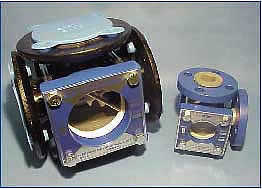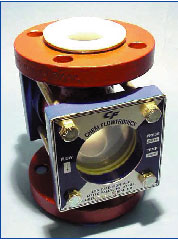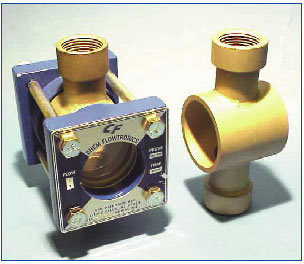Sight flow indicators (SFIs) allow plant engineers to monitor the flow and condition of gases, liquids, or granular solids in a system.
SFIs are either stand-alone piping components or sight windows attached to vessels or tanks.

Pipe Components
Sight flow indicators (SFIs) are inserted directly into the pipeline of a system.

General Information
SFIs inserted in a pipeline allow a user to view the material flowing through a pipeline. They also provide visual confirmation of more sophisticated indicators and controllers. They can be designed to be effective at most any flow, pressure, and temperature.
There are two types of SFIs for pipeline applications: cylindrical and flat-disk window. Shown below is a flat-disk window sight flow indicator.
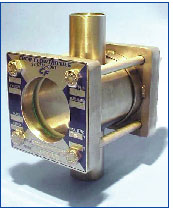
Equipment Design
Cylindrical-type SFIs allow maximum visibility but, because of strength considerations, are limited in use. They can have either an unsheathed or sheathed window .
Unsheathed types, such as the one pictured below on the left, are more commonly inserted in vertical pipelines, but can be used in horizontal pipelines in which only limited strains are put on the indicator. Unsheathed types are sealed on the ends with gaskets to prevent leakage.
Sheathed SFIs, such as the one pictured below on the right, are stronger and used in both horizontal and vertical applications. The sheathed cylindrical sight flow indicator to the left has a metal sheathing surrounding the pipe. Sheathed types can be end-sealed with gaskets but are commonly sealed with stuffing-box seals .
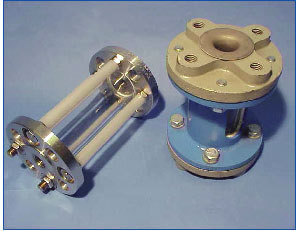
Because they are mechanically stronger, flat-disk window SFIs cover a much larger range of applications than the cylindrical-type. There are five designs of flat-disk window sight flow indicators: flapper, rotary, plain, ball and drip.
Flapper SFIs have a bi-directional flap whose position indicates changes in flow. In most designs, the flap can point in either direction. They are frequently used to view the flow of gases or transparent or slightly opaque solutions. They are not recommended for downward flow.
Rotary sight flow indicators, also known as propeller sight flow indicators, are useful for flow in any direction. The propeller turns, indicating flow and direction. Rotary sight flow indicators are helpful when observations are being made from a distance.
Plain sight flow indicators show flow without the use of internal indicators. They can be installed in any position.
Ball sight flow indicators have a ball inside the sight window that allows the user to monitor the color and clarity of the fluid as well as its flowrate. Generally, ball sight flow indicators are only useful in vertical, low flow applications.
Drip sight flow indicators are recommended for downward, vertical flow. The dripping of fluid through the drip tube shows flow. They are useful in processes with low or intermittent flow.
Both cylindrical-type and flat-disk window type SFIs can be supplied with flanged ends, as shown on the left, or threaded ends, as shown on the right. In some applications, sight flow indicators are welded to the pipes.
(Copyright CHEM Flowtronics, Little Falls, NJ)
Usage Examples
Sight flow indicators can be used in many applications, such as to monitor cooling, lubricant, or fueling lines to engines, compressors, and other industrial equipment. The type of indicator used will depend on the amount of stress the indicator will have to endure and on the visibility required. Pictured below are dual flat window sight flow indicators on a custom biodiesel coalescer/reactor.

Sight flow indicators are also useful in steam applications. The indicators allow a user to detect the presence of condensate that might be harmful to the process.
Sight flow indicators can also be used in filtration systems. By looking at the indicator, the user may see a drop in flowrate or discoloration of fluids, indicating the filter is clogged and needs to be changed or cleaned.
The schematic shows how a pair of sight flow indicators might be arranged to allow an operator to confirm that the system is filtering properly.

Advantages
- Quick and relatively accurate estimate of flow rate, fluid consistency, color, and other vital information.
Disadvantages
- Indicators with metal bodies may corrode.
- Glass breakage possible.
- Cylindrical-type applications limited due to strength considerations.
Sight Windows
General Information
Sight windows are used to see the inside of tanks or processing equipment. There are three types of sight windows: weld, thread, and bolt, named for the way in which they are attached to equipment. The most commonly used type of sight window is the weld-type sight window . A curved base may be used to match the curvature of the tank, vessel, or pipe wall. It is inserted into a hole in the wall and welded directly to the equipment. The windows may be single layer, single layer with a shield, or dual layer.
Equipment Design
Threaded-type sight windows are designed to thread into the end of a pipe. Some designs allow the user to view the pipe interior from any position.
Bolt-type sight windows are bolted to existing flanges in the walls of the tank, vessel, or pipe.
Usage Examples
Sight windows are used to indicate presence of condensate in steam processes or contamination in plant processes. They are commonly used to observe reactions or mixing processes. Sight windows can also be placed in pressure vessels, large pipes, or tanks. Sapphire sight windows are used primarily for IR sensors, explosion and chemical windows, and downhole systems.
Advantages
- Quick and relatively accurate estimate of flow rate, fluid consistency, color, and other vital information.
Disadvantages
- Metal body may corrode if incompatible with fluid.
- Glass breakage possible.
Acknowledgements
- ChemFlowtronics, Little Falls, NJ
References
- McDonough, Roger. “Selecting Sight Flow Indicators.” Chemical Engineering 4 July 1977: 113-116.
Developers
- Melissa Schlosser
- Steve Wesorick
- Henry Chen

